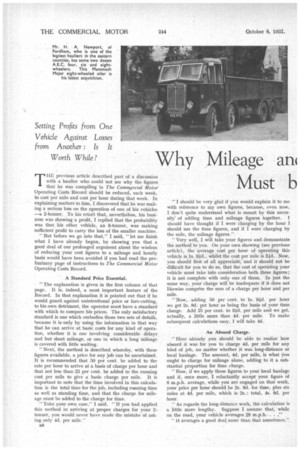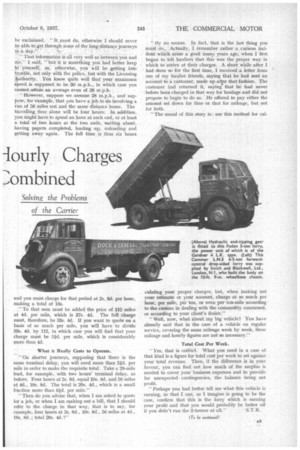Why Mileage an Must b iourly Charges ombined
Page 42

Page 43

If you've noticed an error in this article please click here to report it so we can fix it.
Setting Profits from One Vehicle Against Losses from Another : Is It
Worth While?
TfiE previous article described part of a discussion with a haulier who could not see why the figures that he was compiling in The CoranierCial Motof Operating Costs Record should be reduced, each week, to cost per mile and cost per hour during that week. In explaining matters to him, I discovered that he was making a serious loss on the operation of one of his vehicles —a 2-tonner. To his retort that, nevertheless, his business was showing a profit, I replied that the probability was that his other vehicle, an 8-tonner, was making sufficient profit to carry the loss of the smaller machine.
"But before we go into that," I said, "let me finish what I have already begun, by showing you that a good deal of our prolonged argument about the wisdom of reducing your cost figures to a mileage and hourly basis would have been avoided if you had read the preliminary page of instructions to The Commercial Motor Operating Costs Record.
A Standard Price Essential.
"The explanation is given in the first column of that page. It is, indeed, a most important feature of the Record. In that explanation it is pointed out that if he would guard against unintentional price or fare-cutting, to his own detriment, the operator must have a standard with which to compare his prices. The only satisfactory standard is one which embodies those two sets of details, became it is -only by using the information in that way that he can arrive at. basic costs for any kind of operation, whether it is one involving considerable delays and but short mileage, or one in which a long mileage is covered with little waiting.
"Next, the method is described whereby, with these figures available, a price for any job can be ascertained. It is recommended that 50 per cent. be added to the rate per hour to arrive at a basis of charge per hour and that not less than 25 per cent, be added to the running cost per mile to give a basic charge per mile. It is important to note that the time involved in this calculation is the total time for the job, including running time as well as standing time, and that the charge for mileage Must be added to the charge for time.
"Take your own case," I said. "If you had applied this method in arriving at proper charges for your 2tonner, you would never have made the mistake of asking only 4d. per mile."
"I should be very glad if you would explain it to me with reference to my own figures, because, even now, I don't quite understand what is meant by this necessity` of adding time and mileage figures together. should have thought if I were charging by the hour I should use the time figures, and if I were charging by the mile, the mileage figures."
"Very well, I will take your figures and demonstrate the method to you. On your own showing (see previous article), the average cost per hour of operating this vehicle is is. 94d., whilst the cost per mile is 3id. Now, you. should first of all appreciate, and it should not be difficult for you to do so, that the cost of operating your vehicle must take into consideration both these figures; it is not complete with only one of them. In just the same way, your charge will be inadequate if it does not likewise comprise the sum of a charge per hour and per mile.
"Now, adding 50 per cent. to 1.s. 9id. per hour we get 2s. 8d, per hour as being the basis of your time charge. Add 25 per cent. to 3i-d. per mile and we get, actually, a little more than 4d. per mile. To make subsequent calculations easy, I will take 4d.
An Absurd Charge.
"Here already you should be able to realize how absurd it was for you to charge 4d. per mile for any kind of job, no matter whether it was long-distance or local haulage. The amount, 4d. per mile, is what y-ou ought to charge for mileage alone, adding to it a substantial proportion for time charge.
" Now, if we apply these figures to your local haulage and if, once more, I reluctantly accept your figure of
m.p.h. average, while you are engaged on that work, your price per hour should be 2s. 8d. for time, plus six miles at 4d. per mile, which is 2s. : total, 4s. 8d. per hour.
"As regards the long-distance work, the calculation is a little more lengthy. Suppose I assume that, while on the road, your vehicle averages 28 m.p.h. . . ."
" It averages a good deal. more than that sometimes,". he exclaimed. "It ,must do, otherwise I should never tic able to get through some of the long-distance journeys in a clay."
" That information is all very well as between you and Me," I said, " but it is something you had better keep to yourself, as, otherwise, you will be getting into trouble, not only With the police, but with the Licensing Authority. You know quite well that your maximum .6ipeed is supposed to be 30 m.p.h., in which case you
cannot :attain an average even of 28 rn.ph. ,
" However, suppose we assume 28 m.p.h., and suppose, for example, that you have a job to .do involving. a run of 56 miles out and the same distance home. The travelling time alone will be four hours: In addition, you might have to spend an hour at each end, or at least a total of two hours at the two ends, waiting about, having papers completed, loading up, unloading and getting away again. The full time is thus six hours
and you must charge for that period at 2s. 8d. per hour, making a total of 16s.
" To that sum must be added the price of 112 miles at 4d. per mile, which is 37s. 4d. The full charge must, therefore, be 53s. 4d. If you want to quote on a basis of so much per mile, you will have to divide 53s. 4d. by 112, in which case you will find that your charge must be 51d. per mile, which is considerably more than 4d.
What it Really Costs to Operate.
" On shorter journeys, supposing that there is the same terminal delay, you will need more than 51d. per mile in order to make the requisite total. Take a 28-mile lead, for example, with two hours' terminal delay, as before. Four hours at 2s. 8d. equal 10s. 8c1. and 66 miles at 4d., 18s. 8d. The total is 29s. 4d., which is a small fraction more than GO. per mile," "Then do you advise that, when I am asked to quote for a job, or when I am making out a bill, that I should refer to the charge in that way, that is to say, for example, four hours at 2s. 8d., 10s. 8d., 56 miles at 4d., 18s. 8d.; total 29s. 4d. ?" " By no means. In fact, that is the last thing you must do., Actually, I remember rather a curious incident-which arose a good many years ago, when I first began to tell hauliers that this was the proper way in which to arrive at their charges. A short while after I had done so for the first time, I received a letter from one of my haulier friends, saying that he had sent an account to a customer, made up after that fashion. The customer had returned it, saying that he had never before been charged in that way for haulage and did not propose to begin to do so.. He offered to pay either the amount set down for time or that for mileage, •but not for both.
"The moral of this story is: use this method for cal
culating your proper charges, but, when making out your estimate or your account, charge at so much per hour, per mile, per ton, or even per ton-mile according to the custom in dealing with the commodity concerned, or according to your client's desire."
"Well, now, what about my big vehicle? You have already said that in the case of a vehicle on regular service, covering the same mileage week by week, these mileage and hourly figures are not so necessary."
Total Cost Per Week.
" Yes, that is correct. What you need in a case of that kind is a figure for total cost per week -to set against your total revenue. Then, if the difference is in your favour, you can find out how much of the surplus is needed to cover your business expenses and to provide for unexpected contingencies, the balance being net profit.
" Perhaps you had better tell me what this vehicle is earning, so that I can, as I imagine is going to be the 'case, confirm that this is the lorry which is earning your profit and that you would probably be better off
if you didn't run the 2-tonner at all." S.T.R.




























































































